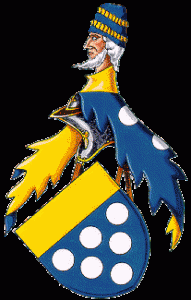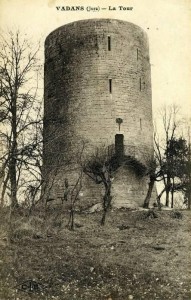Continuing my quest for the serpent-fairies of France, whom I have traced from Lusignan in the Poitou (via the Starbucks logo) to Sassenage in the Dauphiné. Now I track down a monstrous specimen in the Franche-Comté …
 The domed clock-tower of the Collégiale at Dole, completed in 1596, is one of the landmarks of the Jura, visible from miles around. When one squints at it from a distance, it often appears to be crooked. The folklore of the region offers a ready explanation: that La Vouivre, the serpent-woman of local legend, has carelessly knocked it with her wing. She prefers to train her single, luminous eye on the ground below, scouring it for evidence of buried treasure.
The domed clock-tower of the Collégiale at Dole, completed in 1596, is one of the landmarks of the Jura, visible from miles around. When one squints at it from a distance, it often appears to be crooked. The folklore of the region offers a ready explanation: that La Vouivre, the serpent-woman of local legend, has carelessly knocked it with her wing. She prefers to train her single, luminous eye on the ground below, scouring it for evidence of buried treasure.
In mortal life, she was a lady of the house of Poitiers, lords of Vadans on the far side of the mighty Forêt de Chaux, whose name she had tainted with her avarice. The ‘Noblesse de Poitiers’ was proverbial in Franche-Comté, and indeed was the family’s adage, a sort of secondary motto. In those days, great people were expected to be generous with their hospitality. At the Château de Menthon, in neighbouring Savoy, passing pilgrims were regaled at a massive board (which still exists) in the so-called Salle des Pèlerins. At cheerless Vadans, alms were refused to the needy, and none was made welcome by Madame de Poitiers, for which she was condemned by the good fairies to take this terrible shape. Vouivre is a corruption of the Latin word, vipera, for a serpent.
Every Christmas, at midnight, she passes Dole on her flight from Mont Roland to the circular donjon of Vadans, pausing at the village of Falletans to drink and bathe in the stream. A true franc-comtoise, la Vouivre is a good housekeeper, careful to remove her monstrous eye and to conceal it in the undergrowth before dipping her head. If only one could catch her at this moment and take possession of the eye, it would be the key to great riches, yet she always manages to slip away, usually tipping her would-be abductor into the icy stream with a flick of her tail. (Livre d’Or de Falletans 1950.)
 The Poitiers of Vadans were a cadet branch of the comtes de Valentinois in Provence, whose line stretches back to the twelfth century (Europaïsche Stammtafeln, III/4, t.740-43). They are thought to have taken their name from Peytieux, near Châteauneuf-de-Bordette, and in early Latin documents are called ‘Pictavinus’. Though the family was unconnected with the town of Poitiers in the Poitou, ‘Poitiers’ and ‘Peytieux’ are etymologically the same, both places formerly inhabited by branches of a wandering Celtic tribe known variously as the Pictavii or Pictones.
The Poitiers of Vadans were a cadet branch of the comtes de Valentinois in Provence, whose line stretches back to the twelfth century (Europaïsche Stammtafeln, III/4, t.740-43). They are thought to have taken their name from Peytieux, near Châteauneuf-de-Bordette, and in early Latin documents are called ‘Pictavinus’. Though the family was unconnected with the town of Poitiers in the Poitou, ‘Poitiers’ and ‘Peytieux’ are etymologically the same, both places formerly inhabited by branches of a wandering Celtic tribe known variously as the Pictavii or Pictones.
Vadans was the dowry (and favourite residence) of Marguerite de Vergy, wife of Comte Louis, who died in 1345, and was inherited by his nephew Philippe. Also lord of Arcis-sur-Aube, near Troyes, Philippe de Poitiers was killed at the Battle of Agincourt, and is one of the 500 out of the 6,000 French casualties whose names are known to us. Among those 500 are representatives from all the northerly regions of France, though the Seigneur d’Andelot, from Pesmes, is the only other franc-comtois to be listed (http://france3-regions.francetvinfo.fr/hauts-de-france/azincourt-1415-d-ou-venaient-les-chevaliers-francais-morts-la-bataille-797853.html).
The line of Philippe’s grandson Charles, Baron de Vadans, was soon thoroughly assimilated into the noblesse of the Franche-Comté, intermarrying with local families like that of the Chancellor Jean Carondelet, who is commemorated by an impressive tomb in the Collégiale, and whose daughter married Charles’s son. The Poitiers of Vadans died out in 1717, but have left numerous female-line descendants. They include, for example, the seigneurs de Faletans, whose connection with the illustrious Poitiers was recited in the letters-patent on 1712 that elevated them to the rank of marquis. Their seat at Falletans was hard by the stream that la Vouivre is said to haunt annually on her Christmas migration.
An elder brother of the Philippe who died at Agincourt, Louis de Poitiers, succeeded their father as lord of Saint Vallier (on the River Rhône, 19 miles north of Valence). Louis’s son, Charles, was one of the companions-in-arms of Joan of Arc, and played a leading role in the assault of occupied Paris in 1429. The last of the Saint Vallier line was Charles’s great-granddaughter, Diane de Poitiers, the charming mistress of King Henry II, a woman schooled in Latin and Greek, a natural athlete and an unabashed nudist, as her several portraits suggest.
As for Vadans, the forty-metre-high keep alone attests to the former strength and importance of the castle, which overlooks the old Roman road from the site of a Roman encampment. A handsome residence of 1667 occupies the grounds.
See also http://www.rupertwilloughby.co.uk/gleanings/the-legend-of-melusine-how-the-tutelary-fairy-of-the-lusignans-came-to-reign-over-starbucks/ and http://www.rupertwilloughby.co.uk/gleanings/the-legend-of-melusine-at-the-chateau-de-sassenage-in-the-dauphine/.



Trackbacks /
Pingbacks